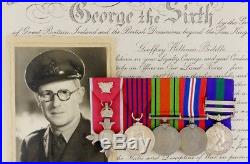
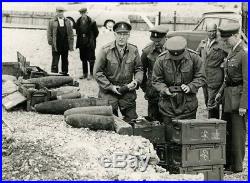
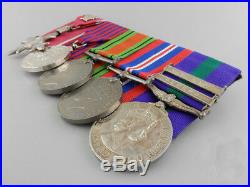
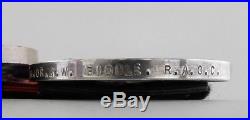
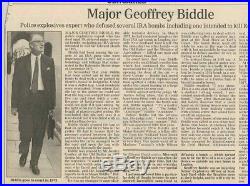
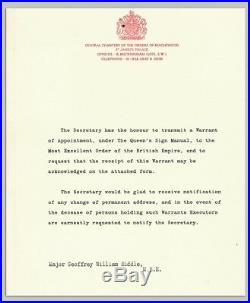
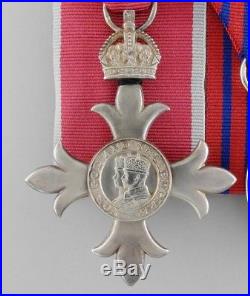
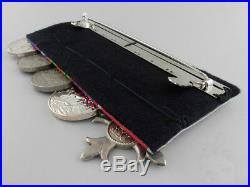
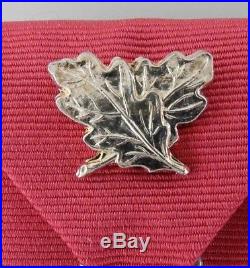
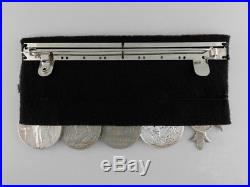
Here we have a Brilliant WW2 MBE George Medal Civil Gallantry Bomb Squad Police Medal Group, Major Biddle served in the Royal Army Ordnance Corps, Metropolitan Police Force and Scotland Yard Bomb Squad, He was awarded the Most Excellent Order of the British Empire, Member (Civil) (frosted silver, oak leaf cluster for gallantry on the ribbon) rare as this was the last year it was issued before being replaced by the Queens Gallantry Medal. Naming is officially impressed on the GSM, the George Medal is a replica as the original is in possession of the family, the other three awards are un-named as issued. Mounted to a suspension with swing bar pinback, replacement ribbons, light contact, near extremely fine. Geoffrey William Biddle was born on May 7, 1917 in Bromley, Kent, England. Biddle enlisted as a Private (7664096) with the Royal Army Ordnance Corps at Brighton, East Sussex on March 5, 1940, in the RAOC he became Ammunition Examiner on May 30, 1942. He was promoted to Acting Staff Sergeant on June 4, 1943 and to Staff Sergeant on December 1, 1943. He was awarded four service chevrons on March 5, 1944 and attended the 29th Regimental Sergeant Majors’ Course at Leicester three months later, on June 1st. He achieved the ranks of Warrant Officer 2nd Class (Squadron Quartermaster Sergeant) on December 28, 1944 and Warrant Officer 1st Class (Sergeant Commander) on November 14, 1945, before being promoted to the rank of Lieutenant, effective January 1, 1947. After the war, Biddle was commissioned as an Ammunition Technical Officer and served in Germany, Kenya, Cyprus and the Middle East, and was later promoted to Captain. While still with the Royal Army Ordnance Corps, Captain G. Biddle (366892) was promoted to the rank of Major, effective August 6, 1959, the announcement appearing in the Supplement to the London Gazette 41782 of Tuesday, August 4, 1959, on Friday, August 7, 1959, page 4917. One of his last tasks as an Army officer was to deal with a parcel marked “Explosives” on an Underground (subway) train near Mansion House. It turned out to be a hoax. Biddle retired from the Royal Army Ordnance Corps in 1964 with the rank of Major. In November 1964, he joined the Metropolitan Police Force in London. By 1964, the Metropolitan Police Force was facing a wave of safe-blowings using gelignite or nitro-glycerine. Explosives left at the scene of bungled robberies had to be made safe and recovered, with Major Donald Henderson advising officers on scene management and evidence collection. Henderson impressed the senior officers so much that he was asked to set up a bomb disposal unit. Now also retired from the Army, Major Henderson, with his friend and colleague, the now retired Army officer Major Geoffrey Biddle, became police explosives officers at the Explosives Office at Cannon Row police station, establishing C7 (2) Branch and became experts in the field. Their early work paved the way for police anti-terrorist operations throughout the 1970s. Both were part of the close-knit civilian team who responded to the Provisional IRA’s mainland bombing campaign, and the Arab attacks later that decade. The Explosives Office was visited by delegates from all over the world, and the procedures Henderson had established were copied widely. Major Biddle was later named Senior Explosives Officer at Scotland Yard and he was no stranger to unpredictable terrorist devices. In March 1973, he had rendered harmless the first IRA (Irish Republican Army) car bomb in London, outside New Scotland Yard itself. On the same day, two bombs, one at the Old Bailey and the other at the Ministry of Agriculture, killed one man and injured more than 200 others. In court later that year, Biddle produced a small black wooden box which had contained the timing mechanism for the 175-pound bomb. Biddle had opened the door of the car, a Ford Corsair, noting the pungent smell of explosives and spotted a white wire running under the carpet leading to a large charge under the rear seat. Biddle agreed with the judge, Mr. Justice Sebag Shaw, that it could have been fitted with a booby trap. Asked how he knew the bomb was not fitted as such, Biddle replied It’s a matter of intuition and er… “, the Judge adding “And hope? “, with Biddle confirming “And hope. Before Biddle left the witness box, the Judge said: “I would like to pay tribute to your courage”. Later that year, Major Biddle was appointed a Member of the Most Excellent Order of the British Empire, along with two others, the announcement and citation appearing in the Second Supplement to the London Gazette 46156 of Monday, December 17, 1973, on Tuesday, December 18, 1973, page 15033-34: CENTRAL CHANCERY OF THE ORDERS OF KNIGHTHOOD St. James’s Palace, London S. The QUEEN has been graciously pleased to give orders for the undermentioned appointments to the Most Excellent Order of the British Empire, and to approve the awards of the George Medal and the British Empire Medal for Gallantry (Civil Division) and for the publication in the London Gazette of the names of those specially shown below as having received an expression of Commendation for Brave Conduct. To be additional Members of the Civil Division of the Most Excellent Order of the British Empire for Gallantry: Major Geoffrey William Biddle, Explosives Officer, Metropolitan Police Office. Captain Richard Vernon Hawkins, Explosives Officer, Metropolitan Police Office. Peter Edwin Spencer Gurney, G. Explosives Officer, Metropolitan Police Office. Following a report that a suspicious car was parked near two buildings which had wide areas of glass in their walls and housed large numbers of staff, Major Biddle and Mr. Gurney went to the scene. Quickly realizing the gravity of the situation they managed to get into the car and immediately recognised the smell of explosives. They saw a cord protruding from beneath the passenger seat which they knew was a detonating cord and this was traced to the rear seat which was lifted and found to be packed with explosives. They now realised they were dealing with a very large bomb and ensured that the immediate area was evacuated and that staff in the surrounding buildings were warned before they began the dangerous task of rendering the device safe. The officers found the initiatory system of the bomb in a wooden box under the front seat; Mr. Gurney severed the detonating cord and together they removed the back seat containing the explosives as far as possible from the initiatory system. They suspected that there might be a second such system and immediately unpacked the seat squab and separated the bags of explosives to reduce the effects of any explosion. When the box was opened it was found to contain a device based on an alarm clock which would have exploded the bomb at 3 p. The car was then searched for further explosives and none being found, it was declared safe. During the morning Major Biddle and Mr. Gurney with other colleagues were extremely busy attending to further suspect car bombs; these turned out to be false alarms. At about 2 p. That afternoon an anonymous call to a newspaper warned that further car bombs had been planted and Mr. Gurney with Captain Hawkins went to deal with one of them. From the earlier events of the day they realised that the time for the detonation of any further bombs might be perilously close and they immediately approached the car and gained access. Again they were met by the distinctive smell of explosives and rapidly located a detonating cord in a position like the one found previously. The bomb was similar to the earlier one and having cut the detonating cord they removed the rear seat squab. Captain Hawkins carefully dismantled the explosive charge and made certain it contained no secondary means of detonation while Mr. Gurney made the initiatory device safe; this was again found to be based on an alarm clock and would have caused the bomb to explode at about 2.50 p. Together the officers searched the car for any further explosives and finally declared it safe. Major Biddle, Captain Hawkins and Mr. Gurney were all involved in exceptional risks and displayed courage of a very high order and in successfully dismantling these bombs they undoubtedly saved a large number of people from very serious injury or even death. The month after the announcement of his award of the MBE, in early January 1974, Major Biddle and Major Ronald Wilson, a fellow officer from the Scotland Yard Bomb Squad, were called to five incidents in two days. One bomb went off at Madame Tussaud’s Wax Museum while Wilson was collecting tools to deal with it, while Biddle was called to another incident at the Boat Show at Earl’s Court. The bomb there went off while he was on the way to deal with it, but meanwhile he was summoned to defuse another device in Ealing, west London. Inside a large plastic carrier bag, he found a 15-pound bomb in a corrugated box stamped with the name of a Dublin firm of biscuit manufacturers. Biddle recalled the incident: I was alone. This is a one-man task. I could hear a distinct ticking sound. I proceeded immediately to defuse the bomb. Only after dismantling it, did Biddle discover a clock hand on its timing device was only thirty seconds from making contact with a brass screw that would have set off an explosion. In the early hours on the next day, Biddle was called to two other incidents: one bomb in Chelsea blew up before he could reach it, the other bomb was in Kensington, in a gray-mottled suitcase that could be seen on the doorstep of the basement of a house occupied by Major-General Sir Cecil Blacker, Adjutant-General. The street lighting had been extinguished. The suitcase was bound tightly with rope, and because of the lack of space in which to work, Biddle was obliged to move it. Inside the case, he found 112 four-ounce gelignite cartridges and was able to dismantle the bomb by undoing battery connections. At the trial of the IRA men sentenced for the bombings, Mr, Justice Melford Stevenson praised both Biddle and Wilson for their efforts. Much of Biddle’s work was carried out in secrecy, but in 1975, a court heard how a bomb sent by a jilted lover blew up in his face, scorching his wrist and eyebrows. He is credited with having defused numerous terrorist bombs, including an IRA device intended to kill Sir Edward Heath in 1975. Heath had been a British politician, who served as the Prime Minister of the United Kingdom from 1970 to 1974 and was the Leader of the Conservative Party from 1965 to 1975, losing the leadership of the party to Margaret Thatcher in February 1975. On November 9, 1975, Biddle had been called out in the early hours, to deal with a car parked by Heath’s house in Belgravia. Under the car was a duffel bag, so all local residents were evacuated. From where Biddel lay in the gutter, he could see that the bag was wedged fast under the car and tied with a cord. Due to the background noise, he could not hear if it was ticking. Biddle pivoted the bag, so that its open end faced him in the gutter. He had to ensure that the pressure contact between the bag and the car was maintained. Reaching under the car, he managed to cut the cord and open the bag wide enough to dismantle the bomb. Biddle was praised for his efforts by Mr. Justice Cantley at the Old Bailey in 1977, during the Judge’s speech when sentencing the terrorists: “I want to commend the men of true worth, unarmed policemen who faced and chased these criminals, and the bomb disposal experts such as Major Biddle”. Major Biddle was awarded the George Medal for his “outstanding gallantry and devotion to duty” in defusing four terrorist bombs, on January 5 & 6, 1974, May 19, 1974 and November 9, 1975. The announcement and citation for his George Medal appeared in the Third Supplement to the London Gazette 47085 of Monday, December 6, 1976, on Tuesday, December 7, 1976, page 16447-48: CENTRAL CHANCERY OF THE ORDERS OF KNIGHTHOOD St. THE QUEEN has been graciously pleased to give orders for the following award of the George Medal. Awarded the George Medal Major Geoffrey William BIDDLE, M. Explosives Officer, Metropolitan Police. Bearing in mind police warnings to be cautious of explosives attached to stationery vehicles, they looked under their car and saw a duffle bag jammed underneath below the front passenger seat. Without interfering with the bag they called the police. Major Biddle was summoned to the scene which had been sealed to traffic and pedestrians and after the initial examination it was decided that the residents of nearby houses should be evacuated before the bag was examined in more detail. There was only a small amount of ground clearance under the car and Major Biddle could see that the tightly wedged object was securely closed by a cord. Being unable to touch the bag he tackled the inspection by lying in the gutter, but because of background noises was unable to decide whether or not the bomb was ticking. Major Biddle slowly pivotted the device so that the opening was facing where he was lying in the gutter; this had to be done very gently so that the pressure contact between the bag and the vehicle remained unbroken. When the bag was close enough he managed to cut the cord, open the bag and this enabled him to disarm the device sufficiently to pull it from under the car and render it completely safe. The bomb would have detonated if the bag had been removed or if the car had been subjected to any movement. Major Biddle has over a period been involved in defusing other terrorist explosive devices. On 5th January 1974 following a day of terrorist bomb activity, he was called to some premises where the area had been evacuated following the discovery of a suspicious object. The device had been placed among several plastic bags in a badly lit position and was seen to contain a clock, batteries and explosives. Major Biddle defused the bomb by cutting the wiring to the batteries and then removed the detonator. He then managed to reach the clock, the setting of which showed that the device was probably within seconds of exploding at the time it was disarmed. In the early hours of the following day, 6th January 1974, Major Biddle was called to the front basement of a house where a suitcase had been left on the doorstep; he noticed that the street lighting was extinguished and the area was in darkness. The suitcase was bound tightly with rope and due to a lack of room in which to work, Major Biddle was obliged to move it from its original position. When the case was opened it was found to contain explosives, a battery and a clock. The bomb was made safe by disconnecting the wire to the battery and removing the detonator. Had this bomb exploded considerable damage and injury could have been caused. Major Biddle also defused a bomb contained in a haversack and left at the rear of some premises on 19th May 1974. Major Biddle displayed outstanding gallantry and devotion to duty in tackling these highly dangerous devices, often under difficult circumstances. Biddle’s George Medal investiture took place at Buckingham Palace and was conducted by Prince Charles, on Tuesday, February 15, 1977. It was also the Prince’s first time conducting an investiture. Biddle is acknowledged as having been an MBE and having received the award in 1976 on the Metropolitan Police Gallantry Awards website, for having defused four terrorist bombs during his work as an Explosives Officer. He retired from policing in 1981. Geoffrey William Biddle died in February 1997 in South East Surrey, Surrey, England, at the age of 79. His wife, Lilian, pre-deceased him in 1987. Sir Edward Heath fondly remembered Biddle after his death, stating: Men such as Geoffrey Biddle are too often the unsung heroes of out time, but the freedom we enjoy in our everyday lives depend upon such very special men. I personally owed him a particular debt of thanks because he once showed incredible sang-froid (from the French: cold blood) in defusing a bomb, which turned out to be the first of a new type of device, outside my own home in London. Geoffrey Biddle was an inspiring Senior Explosives Officer at Scotland Yard while the Troubles were at their height, and he will truly be missed. ” (C:106) The Set is Accompanied by his Commission Document named to “Geoffrey William Biddle, Lieutenant, Land Forces, promoting him to the rank of Lieutenant, effective January 1, 1947, dated May 9, 1947 at St. James Palace, stamped signature of George VI, two other signatures, embossed seal of Princess Elizabeth, 303 mm x 407 mm; his Second World War Soldier’s Service and Pay Book (handwritten entries, 100 mm x 127 mm, wear evident on the cover); a Letter from the Central Chancery of the Orders of Knighthood, St. James Palace addressed to Major Geoffery William Biddle, M. “, in regards to the Secretary transmitting a Warrant of Appointment to the Most Excellent Order of the British Empire, 198 mm x 238 mm; a Letter from the Metropolitan Police (dated October 15, 1980, with attached letter received from the West German Embassy dated October 10, 1980, 210 mm x 297 mm); a NATO Pass numbered “818, with an expiry date of June 30, 1960 in French, signed by Major Biddle U. Delegation and NATO Head of Security Service, 78 mm x 110 mm; a New Scotland Yard C7 Branch Athletic & Social Club Membership Card (numbered “102″, signed by the Honourary Secretary of the Club, 60 mm x 92 mm); a Special Forces Club Membership Card named to G. Biddle”, dated October 1979/80, signed by the Club Secretary, 59 mm x 80 mm; two The Snowball Club Ladies’ Night For Charity Tickets (numbered “254″ and “255, 114 mm x 150 mm); forty-four Photographs (black and white or colour, two portraits in uniform, three in the field, the remaining photos of friends, family and award ceremonies, various sizes); numerous newspaper articles c. 1970s; thirty business cards (most of which are card-mounted), along with assorted research papers. This medal group would be perfect for medal dealers, rare medal group collectors, bomb disposal, police collectors, museums, displays, christmas gift and much much more! The item “Brilliant WW2 MBE George Medal Civil Gallantry Bomb Squad Police Medal Group” is in sale since Sunday, January 13, 2019. This item is in the category “Collectables\Militaria\World War II (1939-1945)\Medals/ Ribbons”. The seller is “knightofengland2011″ and is located in Gainsborough. This item can be shipped worldwide.
- Clothing Type: Medals
- Issued/ Not-Issued: Issued
- Service: Home Front/ Civil Defence
- Modified Item: Yes
- Featured Refinements: Medal Group
- Era: 1945-Present
- Type: Medals & Ribbons
- Country/ Organization: Great Britain
- Country/Region of Manufacture: United Kingdom
- Modification Description: George Medal is a Museum Quality Replica
- Conflict: World War II (1939-1945)